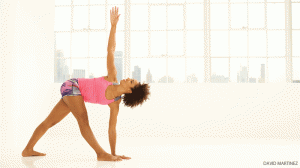Revolved Triangle melds two different dynamic energies: rooting down into the earth with the legs, and sending energy, or prana, up through the extended arm. The pose is a classic representation of what Patanjali, in the Yoga Sutra, describes as the union of sthira and sukha—effort and ease, hard and soft, expanding and contracting, ascending and descending, and solar and lunar.
Joining opposing forces is a handy skill to cultivate and practice: Life frequently demands finding balance between two conflicting desires—for instance, finding love and maintaining independence, or building a career while being a devoted parent—and engaging both, to ever-changing degrees, simultaneously.
You might think Parivrtta Trikonasana (Revolved Triangle Pose) is all about twisting, but as soon as you reach for the floor, you realize it is also a delicate balancing posture that will feel completely steady and comfortable—if you know how to use your legs and core muscles for support. When alignment is correct, the posture can create strength and flexibility in the hamstrings and establish balance both physically and energetically. It can generate a steadiness of mind and a sense of complete freedom. As you take one hand to the earth (or a block), and reach the other to the sky, you find stability and are able to stand your ground while surrendering to both the present moment and the mystery of tomorrow.
In Revolved Triangle, the spine runs parallel to the floor and the descending arm runs perpendicular. With the front leg, these three lines of the body form a right-angle triangle—a stable, structurally sound shape. This means there is no lateral flexion, or side bending, in this pose. If you are tight in the hamstrings and therefore the hips, and if you’re feeling pressured by your own ego (or even a teacher), you can easily lose your balance and critical extension in your spine as you try to place your bottom hand on the floor and twist open into the full expression of the pose. You’ll end up folding forward from the back instead of the hips, losing core stability and grounding in the legs, and even squeezing the front edges of the vertebral discs that are meant to divide the vertebrae. Repetitive compressed folding and twisting, without a lifted chest and an extended spine, can result in back injuries over time that take months, if not years, to recover from.
To practice the pose safely, you need to be aware of your hamstrings’ flexibility and adjust with props and a modified stance so that too-tight (or too-loose) muscles don’t stop your spine from staying parallel to the floor. Tight hamstrings are common, from running, biking, and sitting at a desk all day, but you could also have the opposite problem: Students with long legs and flexible hamstrings consistently take a stance that is too short for their height, so when they dive down into the pose, their heads hang way below their hips, eliminating all right angles and core stability from Revolved Triangle.

Leave a Reply